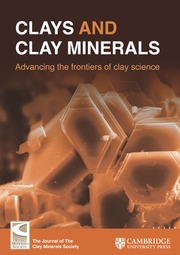Article contents
Iron-Pillared Montmorillonite As An Inexpensive Catalyst For 2-Nitrophenol Reduction
Published online by Cambridge University Press: 01 January 2024
Abstract
Many types of oxidative pollutants are dangerous chemicals and may pose a health risk, but an inexpensive and effective method for mitigating those risks would offer significant advantages. The objective of this study was, therefore, to investigate the potential for Fe-pillared montmorillonite to fill that gap. Surface mediated reduction reactions by ferrous species often play an important role in governing the transport, transformation, and fate of hazardous oxidative contaminants. Compared to the untreated montmorillonite (Mnt), the synthetic polyhydroxyl-Fe pillared montmorillonite (Fe-Mnt) was found to be somewhat similar to goethite in promoting the ability of specifically adsorbed Fe(II) to reductively transform 2-nitrophenol (2-NP). The 2-NP was efficiently removed within 30 min from solutions at the optimum neutral pH in a mixed reduction system of Fe(II)/Fe-Mnt under an anoxic atmosphere. This demonstrated that the specifically adsorbed Fe(II) of Fe-Mnt can enhance 2-NP reduction. The highly enhanced 2-NP reduction by Fe(II) through Fe-Mnt surface catalysis can, therefore, be ascribed to clearly increased amounts of an adsorbed Fe(II) species surface complex, which gave rise to enhanced Fe(II) reductive activity that enabled the rapid reduction of 2-NP. The reduction processes produced a faster transformation of 2-NP in a Fe-Mnt suspension than in a Mnt suspension. The transformation kinetics were described using pseudo-first-order rate equations. Moreover, in addition to the effects of mineral surface properties, the interactions were affected by the aqueous chemistry, and the removal rates of 2-NP were increased at pHs of 6.0–7.3. In the present study, the structure and surface reactivity of Fe-Mnt was characterized in depth. The polyhydroxyl-Fe added to Mnt and the pH were determined to be the two key controlling factors to mediate the reductive transformation of 2-NP in the presence of Fe-Mnt in comparison to goethite and Mnt. Finally, the catalysis mechanism responsible for the enhanced 2-NP reduction by Fe(II) was elucidated using cyclic voltammetry.
Keywords
Information
- Type
- Article
- Information
- Copyright
- Copyright © Clay Minerals Society 2018
References
- 8
- Cited by

